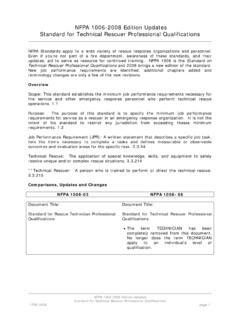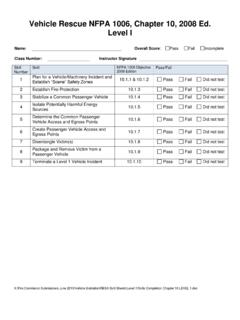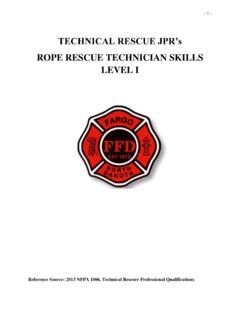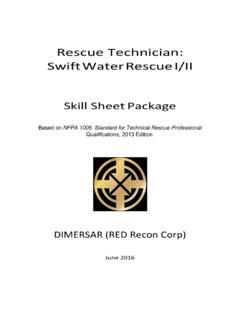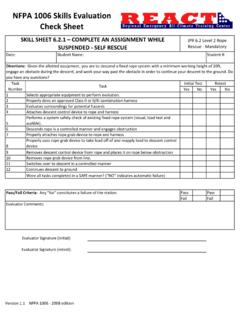Transcription of The NFPA Standards - International Tech Rescue Symposium
1 The nfpa Standards and the Confusion within the Fire Service Presented by: Jim Kovach The nfpa Standards and the Confusion within the Fire Service Our presentation will be on the nfpa Standards that apply to rope Rescue and the confusion within the fire service over interpreting those Standards . We will look at several Standards and how they are interpreted by team leaders and instructors and how they affect the decisions made by firefighters and their Rescue teams. About the Presenter Jim Kovach has been a firefighter with the Fairview Park Fire Department in Ohio for 30 years. He has presented at several past NATRS and ITRS symposiums over the years on a variety of topics, including Tower Rescue , Personal Escape, Fall Factors, Bottom Belaying and equipment testing. The nfpa Standards and the Confusion within the Fire Service It is my belief that some of us in the fire service, are confused and do not understand the nfpa Standards as they apply to rope Rescue .
2 There are 4 nfpa . Standards that address technical rope Rescue : nfpa 1983 the Standard on Fire Service Life Safety Rope and System Components which was first issued in 1985, the current edition is 2001 with a new edition expected in 2006. nfpa 1500 the standard on Fire Department Occupational Safety and Health Program which was first issued in 1987, the current edition is 2002. nfpa 1670 the Standard on Operations and Training for Technical Search and Rescue Incidents which was first issued in 1999, the current edition is 2004. nfpa 1006 the Standard for Rescue technician Professional Qualifications which was first issued in 2000 and the current edition is 2003. Each standard has different committee members and as you can see, each standard has a different revision date. I believe the fact that they are revised in different years has lead to some of the confusion. I am not a member of the nfpa , nor have I ever attended an nfpa meeting.
3 Most firefighters are not members of nfpa but many of our departments are. I am here in support of the nfpa Standards . I believe they are necessary for the fire service and I welcome them. I also have a great deal of respect for the committee members and I'm grateful for their time, their dedication, and their involvement in this process. They have a difficult job and I appreciate their efforts. My personal confusion with the Standards resurfaced, when I was ordering equipment for our fire school. In anticipation of teaching tower classes, I met with some of our instructors and proposed the idea of using 11mm rope instead of mm rope for tower Rescue . A rescuer can carry 200 ft of 11mm PMI rope and it weighs the same as 150 ft of PMI rope. Naturally there was some discussion that centered on the nfpa Standards and the use of 11mm rope and whether or not 11mm was acceptable as a two person rope.
4 Our instructors come from different departments and are on different Rescue teams and have attended a variety of different rope classes. They all embraced the use of the lighter rope but anticipated questions from our students concerning the use of the 11mm one person rope vs. using two person rope. So why do I believe the fire service is confused by these Standards ? I believe a good portion of our confusion is caused by fire service instructors, including myself. I think that we, as instructors, have not kept abreast of the Standards and 1. have perpetuated some of the misunderstanding. An example of this would be my previous statement where I referred to one person rope and two person rope. These load classifications were changed in the 2001 edition of nfpa 1983, and my use of the terms one person rope and two person rope is incorrect. nfpa 1983 is NOT written to be used by the fire service.
5 Once we accept this statement some of the confusion should clear up. The nfpa standard 1983 IS. written to be used by manufactures in making the equipment that we, the fire service, and others that follow the standard, will ultimately use. This is stated in Chapter 1, of 1983 and I quote This standard shall specify minimum design, performance, testing, and certification requirements for new life safety rope and new system components including escape rope, water Rescue throwlines, life safety harnesses, belts, and auxiliary equipment used for Rescue and training by the fire service or similar emergency service organizations.. The first two lines are the most important. In the fire service we don't design, we don't test and we don't certify the rope or equipment that we use. That is done by a third party and if the fire service or anyone else wants to use nfpa . compliant equipment, then that equipment must meet the 1983 Standard.
6 The fact that 1983 is NOT a user standard, is clearly stated in the first chapter in the 2001. edition. It states This standard shall not apply to use requirements for fire service life safety rope and system components as these requirements are specified in nfpa 1500, Standard on Fire Department Occupational Safety and Health Program. Again, the 1983 standard shall not apply to use requirements . nfpa . is very clear about this, but we in the fire service either didn't read this or chose to ignore it. On August 8th of this year I called the nfpa and spoke to Larry Stewart who confirmed this and further stated, 1983 is a product standard . And this confirmed what I was told by nfpa 1983 Staff Liaison Bruce Teele in June. He also said, quote it is not a user standard but a product standard . He continued On the user side it is to be used as a reference with purchasing specifications.
7 End of quote. It should be noted, this statement was not in any of the previous Standards , but was added to the latest edition of 1983 in 2001. So nfpa 1983 referenced nfpa 1500 which is also referenced in nfpa 1670. The reference to 1500 in 1670 is in Chapter 4 General Requirements under the section titled Safety . It references: Section , Special Operations; Chapter 7, Protective Clothing and Protective Equipment; and Chapter 8, Emergency Operations. And this is part of the confusion. Chapter 8 of 1500 is broken down into 8 areas and none of these address the use of rope or equipment as indicated in nfpa 1983. Chapter 7 of 1500 addresses Life Safety Rope and System Components. It discusses how to inspect rope and if it passes inspection it can be reused, what to do if rope does not pass inspection, and documenting rope usage. It also states all life safety ropes, harnesses, and hardware used by fire departments shall meet the applicable requirements of nfpa 1983.
8 2. So nfpa 1983 refers us to 1500 for use requirements and Chapter 7 of 1500. states that our ropes should meet the requirements of 1983, but says nothing about how to use the equipment at a Rescue , other than, we can re-use a rope that is no longer a new rope, if it passes inspection. Chapter 5 of 1500 addresses Training and Education. In a section on Special Operations Training it states: Members expected to perform technical operations as defined in nfpa 1670, Standard on Operations and Training for Technical Rescue Incidents, shall meet the training requirements specified in nfpa 1006, Standard for Rescue technician Professional Qualifications.. So, again, 1500 does not address how to use rope or equipment but does refer us to NFPA1006. In Chapter 1 of 1006 it states This standard establishes the minimum job performance requirements necessary for fire service and other emergency response personnel who perform technical Rescue operations.
9 This standard is about performance requirements of the rescuer. It does not address how to use rope or equipment, and it DOES NOT mandate training requirements as implied in Chapter 5 of nfpa 1500. In an answer to a question I. asked of the 1006 committee, Mr. Frank E. Florence, the liaison to 1006 replied, nfpa 1006 is not a training document.. So nfpa 1983 refers us to 1500 for use requirements, which 1500 does not have, and 1500 refers us to 1006 for training requirements, but 1006 is not a training document. The fourth standard is nfpa 1670. In Chapter 1, it states, The purpose of this standard shall be to assist the authority having jurisdiction (AHJ) in assessing a technical search and Rescue hazard within the response area, to identify the level of operational capability, and to establish operational criteria.. 1670 is an organizational document. In a phone conversation with Don Cooper the chairman of 1670, he stated, The standard does not describe how a procedure is done, it describes what needs to be done.
10 All four of these nfpa Standards define the word approved as, Acceptable to the authority having jurisdiction. This is further explained in the appendix. Approved. The National Fire Protection Association does not approve, inspect, or certify any installations, procedures, equipment, or materials; nor does it approve or evaluate testing laboratories.. So the Standards do not approve or certify any installations or procedures. For example, that means it is up to the AHJ if they want to run a belay along the ground or through a pulley at the top of a tripod. Or the AHJ can choose not to use a belay at all. Which brings up the question: Do the nfpa Standards require a belay for rope Rescue or training? And a related question, Do the nfpa . Standards permit the use of single rope techniques? 3. It has been stated several times now that nfpa 1983 is not a user standard so we won't find the answers to these questions there.
